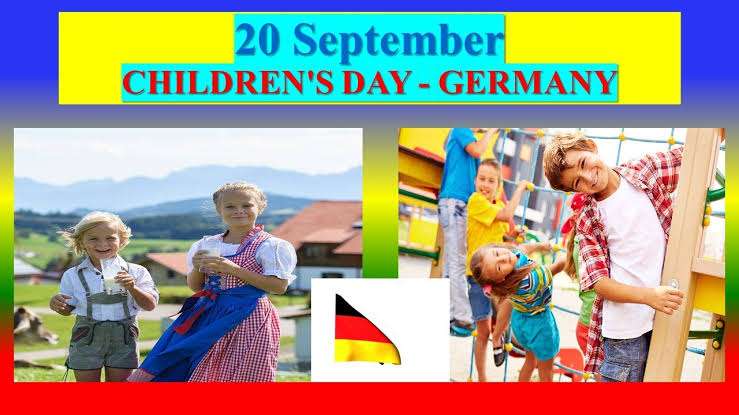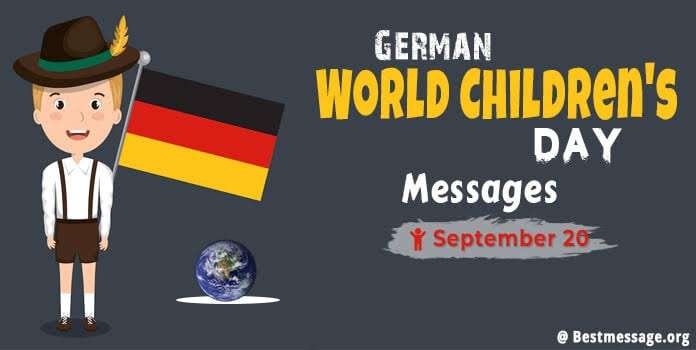German World Children’s Day – September 20, 2022, history, significance why we celebrate
German World Children’s Day on September 20 is the official children’s day of Germany, one of two children’s days recognized in Germany every year. While all Germans agree that celebrating their youngest citizens is a grand idea, they don’t all agree when to do it. While two children’s days are recognized in Germany, both days are celebrated but not by everyone. And the official day, German World Children’s Day, is not celebrated unilaterally by German families.
When to celebrate its children is a source of contention deeply rooted in Germany’s history. To understand this divide requires a shallow dive into Germany’s not too distant past. It’s a dive worth making because it ultimately reminds us how important it is to overlook our political biases and come together for the sake of the planet’s most precious resource, our children.
HISTORY OF GERMAN WORLD CHILDREN’S DAY

The story of Germany’s two children’s days begins in 1954, after World War II when two independent and separate German states existed, East Germany and West Germany. The United Nations (UN) General Assembly resolved that year for all countries to celebrate a Universal Children’s Day promoting international togetherness and improving the welfare of children worldwide.
Although the UN resolution designated November 20 as Universal Children’s Day, at the same time they also suggested that each individual country should select a meaningful date appropriate for their own people to celebrate as Universal Children’s Day. Consequently, some countries chose to celebrate their children on November 20, but many countries elected to celebrate Universal Children’s Day on other dates throughout the year.
West Germany chose to organize a Universal Children’s Day as “Weltkindertag,” or World Children’s Day, on September 20, 1954 in response to the UN’s Universal Children’s Day resolution. At the same time, East Germany chose not to recognize Universal Children’s Day at all, but instead continued to celebrate “Internationaler Kindertag,” or International Children’s Day on June 1, a holiday East Germans had been celebrating since about 1926, long before World War II. If you’re familiar with post-war German history, you probably see where these choices lead when unification takes place in 1990.
To confuse matters more, the UN changed the name of their November 20 Universal Children’s Day to World Children’s Day sometime along the timeline, although we’re not exactly sure when. So German Children’s Day is also known as Universal Children’s Day by former West German families. Confused? So are we, but here’s the good news. Although Germany today officially recognizes only one official children’s day, two children’s days still exist, and both are celebrated, so children win
GERMAN WORLD CHILDREN’S DAY TIMELINE
1925
International Children’s Day proclaimed
The World Conference on Child Welfare convenes in Geneva, Switzerland and proclaims June 1 as International Children’s Day.
1926
International Children’s Day in East Germany
East Germany chooses to celebrate International Children’s Day on June 1.
1954
Introduced in East Germany
United Nations Universal Children’s Day Resolution passed
West Germany chooses to participate in Universal Children’s Day but chooses September 20 as its day to celebrate as German World Children’s Day – East Germany continues to celebrate International Children’s Day on June 1.
1990
East and West Germany reunification
September 20 becomes the official day to celebrate Germany’s children when East and West Germany are reunited.
2020
Ninety countries celebrate children
Today Germany and 89 other countries celebrate World Children’s Day or Universal Children’s Day on as many as 50 other different dates throughout the year.
GERMAN WORLD CHILDREN’S DAY ACTIVITIES
Throw a Skype party for the kids
A party is the proverbial no-brainer thing to do when it comes to celebrating any day that revolves around children. Since we’re stuck indoors, send a Skype or Zoom invite to the neighborhood kids, the grandkids, school chums or family and make the theme all about Germany by making German treats, dancing to German folk music and learning a few German words and phrases.
Twist up a batch of pretzels
Tie an apron on every member of the family, roll up your sleeves and have fun twisting up a batch or two of what is undoubtedly Germany’s most famous food enjoyed around the world: pretzels. Known as brezel, brezn or breze in the German language, make a batch of both soft and hard varieties with savory or sweet flavors, of course in the familiar knot-like traditional pretzel shape.
Travel to Germany
…on a virtual trip. Search for videos from each of German’s 13 diverse regions on the internet and take a virtual vacation to Deutschland. Each region has a unique culture of music, art, song and dance, castles with plenty of legends and fairy tales, that are sure to spark the imagination of children and adults alike.
FIVE SCRUMPTIOUS GERMAN FOODS CHILDREN LOVE
Spaetzle
Spaetzle is the German equivalent of American macaroni and cheese, always a childhood favorite.
Schwarzwald Kirsche Kuchen
Authentic German Black Forest cake actually did originate in Germany’s Black Forest region, and is rich with chocolate and cherries.
Apfelstreusel
Apfelstreusel is simply the German version of America’s popular bakery treat, apple strudel.
Kartoffelpuffer
These pan-fried shredded potato pancakes are made similar to potato latkes and a favorite of German children.
Sauerbraten
Sauerbraten is Germany’s famous pot roast, traditionally marinated in red wine, vinegar and spices for two days before roasting.
WHY WE LOVE GERMAN WORLD CHILDREN’S DAY
More than just fun and games
German World Children’s Day reminds the world’s adults how important it is to set aside political and cultural differences to support and invest in the one common denominator that unites our planet with hope for a better future: children.
Fun and games
Although the first German World Children’s Day was more about protecting the rights of children around the world than playing games and giving presents today reminds us that children learn best when the learning is fun.
It’s a small world
German World Children’s Day reminds us that children and families around the world are not all that different from each other.
GERMAN WORLD CHILDREN’S DAY FAQS
What is the origin of Children’s Day?
In 1925, International Children’s Day was first proclaimed during the World Conference on Child Welfare in Geneva, Switzerland. This day is still celebrated on June 1 in many countries. However, in 1954, the United Nations resolved that November 20 should be Universal Children’s Day, which later became known as World Children’s day; at the same time he UN suggested that each country should choose a date that was appropriate and met the needs of for their own people to celebrate.
How many countries celebrate a national or international children’s day?
Today no fewer than 90 countries around the world celebrate at least one children’s day each year, on at least 50 different calendar dates.
What is World’s Children’s Day?
World’s Children’s Day is a global holiday occurring on different dates around the world celebrating the next generation, their purity, and their potential.



